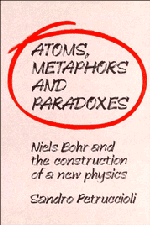Book contents
- Frontmatter
- Contents
- Introduction
- 1 The paradigm of complementarity
- 2 Atomic model and quantum hypotheses
- 3 The principle of correspondence
- 4 The theory of virtual oscillators
- 5 The conceptual foundation of quantum mechanics
- 6 The Bohr—Einstein confrontation: phenomena and physical reality
- General bibliography
- Name index
- General index
1 - The paradigm of complementarity
Published online by Cambridge University Press: 10 November 2009
- Frontmatter
- Contents
- Introduction
- 1 The paradigm of complementarity
- 2 Atomic model and quantum hypotheses
- 3 The principle of correspondence
- 4 The theory of virtual oscillators
- 5 The conceptual foundation of quantum mechanics
- 6 The Bohr—Einstein confrontation: phenomena and physical reality
- General bibliography
- Name index
- General index
Summary
‘The new wave mechanics gave rise to the hope that an account of atomic phenomena might be obtained which would not differ essentially from that afforded by the classical theories of electricity and magnetism. Unfortunately, Bohr's statement in the following communication of the principles underlying the description of atomic phenomena gives little, if any, encouragement in this direction.’ This comment is to be found in the brief note prefaced by the editors of the British journal Nature to Niels Bohr's paper ‘The Quantum Postulate and the Recent Development of Atomic Theory’ in the supplement of 14 April 1928. The article in question is the famous paper which first introduced and defined the concept of ‘complementarity’ and outlined the basic points of what was to become known as the Copenhagen interpretation of quantum mechanics.
In the paper, Bohr returned to the arguments contained in the paper discussed at the International Congress of Physicists held at Como in September 1927 to mark the centenary of the death of Alessandro Volta and published in the proceedings of the same congress. It was probably his conviction that the new viewpoint adopted in the description of nature fully expressed the theoretical and cognitive content of quantum physics coupled with his enthusiasm at having achieved ‘after many years of struggling in the dark […] the fulfilment of the old hopes’ that induced him to give his work broader and more prestigious circulation.
- Type
- Chapter
- Information
- Atoms, Metaphors and ParadoxesNiels Bohr and the Construction of a New Physics, pp. 10 - 35Publisher: Cambridge University PressPrint publication year: 1993

